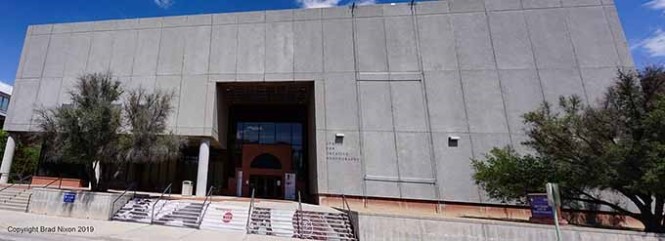
In the last post of this series, I wrote about my trip to Tucson, Arizona, in July. A highlight of the trip for me and my partner was our visit to the University of Arizona Center for Creative Photography.
About the Center
In 1975, legendary American photographer Ansel Adams (1902-1984), along with Dr. John P. Schaefer, then University of Arizona president, cofounded the Center for Creative Photography. Adams also entrusted his entire photographic collection and archive to the Center’s care. The archives of other masters followed, growing to a current 270.
Adams’ and Schaefer’s shared vision for the new institution was to create an educational, collecting, preservation, and exhibition facility that would include the work of many photographers. Today, the center holds more than 110,000 works by over 2,200 photographers and is recognized as one of the world’s premier academic art museums and study centers for the history of photography.
Why Arizona? While Adams’ work is closely associated with California’s Yosemite Valley, he produced a wide range of work throughout the American West, including photos of many iconic Arizona places –– among them, the Grand Canyon, Mission San Javier Del Bac, and Saguaro National Park below.

Known for his striking black and white landscapes, Adams published some of his first color work in popular travel magazine Arizona Highways in the mid-1940s. He continued to sell photos to the publication in the 1950s.
We had a lot on our Tucson agenda, but for us the Center was a “must see.” We happily spent a goodly part of an afternoon there, seeing and absorbing as much as possible before reaching that saturation point that even the most intrepid museum goers experience.
If you’re an enthusiastic photographer or photography fan, you’re sure to find stimulation and inspiration in the Center’s collection and special exhibitions.
The Exhibition: A Portrait of Poetry
On our July visit, the special exhibition was an intriguing portrait project by photographer and poetry lover, B.A. Van Sise. Mr. Van Sise’s family lineage goes back to groundbreaking American poet Walt Whitman (1819-1892), and the project was in celebration of the 200th anniversary of Whitman’s birth.
Also an homage to Whitman’s masterpiece, Leaves of Grass, the show comprised about 80 photos of contemporary poets, primarily a who’s who of Pulitzer Prize winners, Poet Laureates and Chancellors of the Academy of American Poetry. Among them was one video portrait of acclaimed poet Sharon Olds.
Adjacent to each poet’s portrait was the text of one of his or her poems. Per Van Sise’s treatment of his subjects, each portrait was, as the Center noted, “at once a likeness of the poet, an evocation of the poem, and a presentation of a visual narrative fashioned by the photographer.” That tripartite quality created a thought-provoking experience.
We saw many familiar poets in the show, such as Nikki Giovanni, Joyce Carol Oates and Rita Dove. There were also several new discoveries, and we each made a list of poets to pursue further.
Van Sise’s book based on the expansive, three-year project — Children of Grass: A Portrait of American Poetry — was published in September 2019. See the Resources section below for more about both.
Exploring the Center’s Collection
The Van Sise show was absorbing, and it took some energy to get through it all, but we made it and pushed on to the adjacent gallery for a related show of items from the Center’s collection: selected photo illustrations that noted photographer Edward Weston (1886-1958) provided in 1941 for a new edition of poet Walt Whitman’s Leaves of Grass.
In the same gallery, we viewed other Weston photos and poked through drawers of various Ansel Adams materials –– personal photos, letters, and other memorabilia, tools he used in his studio, contact sheets. With our heads spinning, we headed to lunch. No time for more this trip, but we look forward to next time.
Planning Your Visit
Located on the University of Arizona’s urban campus with convenient parking nearby, the Center is free and open to the public. Its many offerings include free guided tours, research capabilities, and small-group viewings of items from the collection. Contact the Center for scheduling requirements.
For more information about the Center, directions, hours and current exhibitions: https://ccp.arizona.edu/home.
Van Sise Project Resources
To learn more about photographer B.A. Van Sise, his range of work and creative projects, see: https://bavansise.format.com/
For an interview with Mr. Van Sise about his photo book, Children of Grass: A Portrait of American Poetry, containing many of the photos we saw in the Center’s exhibition above, see: https://petapixel.com/2019/11/27/an-interview-with-photographer-b-a-van-sise/
The Van Sise exhibition opened at the Center in June 2019, and his related book was published in September. To find the book, including at an indie bookstore in your area: https://bavansise.format.com/children-of-grass
Copyright M. Vincent 2019
Center for Creative Photography photo copyright Brad Nixon 2019, used with permission. Saguaro National Park photo by Ansel Adams is in public domain.

After so many years, I never can remember what I’ve mentioned, or to whom. I may have left a note on Brad’s blog about Ansel Adams’s ‘lost’ Los Angeles photos. A friend put a gallery of them on Flickr; you can see them here.
If you click ‘show more,’ you’ll open a new window with information about how Gerard discovered them. The LA Library website has changed a bit, but a search revealed that the photos still are among their holdings (link below). It seems that Adams didn’t entrust his entire collection to the Center for Creative Photography. Self-curation at its best? Maybe.
The double exposure in the sixth row down is one of my favorites among the photos. Did he intend it? Perhaps. But I like thinking that even the master could end up with one of “those” in his portfolio.
LikeLiked by 1 person
Here’s the link to the Adams LA collection at the library.
LikeLike